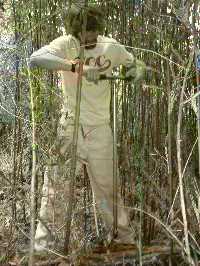
Rivercane on the Cheoah
American Whitewater recently received a grant which provides an opportunity to explore the reintroduction of rivercane (Arundinaria gigantea) to the Cheoah River. The North Carolina Department of Commerce's 21st Century Community program, Western Regional Office, proposed the project and obtained the grant in their efforts to develop a sustainable economy for Graham County. This grant was provided by Revitalization of Traditional Cherokee Artisan Resources which is a Cherokee Preservation Foundation program ultimately funded by the Eastern Band of Cherokee Indian. Rivercane is on the decline in the southeast due to development and agriculture. Landowners have destroyed rivercane because of a lack of understanding of the benefits of rivercane and the fact that it blocks their view of the river. The grant has recent master’s of Biology graduate from Western Carolina University Adam Griffith developing a plan of action on the river corridor. Adam has been researching rivercane, along with many other students and professors, for the past three years at Western and has compiled the research in his thesis on the chemical and physical characteristics of rivercane. Rivercane research at WCU has clocked hours of field time at test sites throughout western North Carolina and has instilled an intimate understanding of the soil properties affecting rivercane.
For the Cheoah project Adam is using Geographic Information System (GIS) tools to help in the
selection of sites that will be tested for soil characteristics best suited for rivercane.
Through the use of GIS, he has found areas of low slope along the river corridor, which has
narrowed his search for the sites that best suit rivercane. Currently Adam has found, low
slope areas within 200 meters of the Cheoah River to be supportive of rivercane.
While exploring the Cheoah watershed Adam has found some already existing sites at the commercial
put-in and a few more along different sections of the river. Currently, Adam is collecting
soil samples at specific sites to evaluate the chemical and physical soil properties to find
areas where rivercane can thrive. Along with the soil analyses, he is evaluating the plant
life around the soil test sites. Adam has found some exotic encroaching species that may
have some effect on rivercane. “Japanese honeysuckle, kudzu, Princess Tree all are
capable of out competing rivercane. Honeysuckle and kudzu climb up and over cane, the tree
blocks the sunlight and grows quickly when young” outlined by Adam.
Rivercane has distinct ecological and cultural advantages, which have fueled research for
reintroduction of this species. The ecological benefits of this native species are
substantial. Rivercane has massive networks of rhizomes and roots that help promote bank
stability and integrity.
